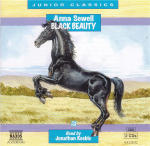
HOME || Art|| Biography || Business || Crime Stories || Fiction || Foreign Languages|| Healthy Living || History || Humor ||
Kids Books Radio Shows || Spiritual || Self Help || TV/Film ||
Black Beauty
Written By : Anna Sewell
Narrated By : Jonathan Keeble
Published By : Select Music & Distribution
Length : 2 hours 15 minutes
Type : Juvenile
Price : $11.99
Purchase...
Black Beauty, the friendly, patient stallion with a white blaze upon his forehead, is one of the most familiar figures in childrens' literature.
After the first lively carefree years in the fields, Black Beauty learns to accept the saddle and bridle and the rule of her masters. But a succession of misfortunes shows that the life of a horse can be harsh and painful. This touching portrait, full of drama and sadness, is as moving now as when it was
first written in 1877.
There never was a more good tempered, handsome or courageous horse than Black Beauty. From the time kind Squire Gordon took him in hand as a foal, to his last, quiet home with the Misses Blomefield and Ellen, Black Beauty never did less than his best. But it was not always an easy life from a horse's point of view, as Black Beauty himself describes.
Passing from one owner to another, he learns of the drunken cruelty of masters, ladies determined to follow the fashion, whatever the hurt to their carriage horses, and cab-men who would run their horses into the ground, rather than treat them well. Yet whatever misfortune comes to him, Black Beauty bears it nobly.
Black Beauty's tale is not just a well-told story. He offers an insight into a past that is difficult to imagine today. In those days, once you left the train, there were only two ways to get around, on foot and by horse. The hill that you speed up in a car had to be conquered step by step, and if you were a horse, going down the other side with a heavy load was not much easier.
In real life the sufferings of harness horses in Victorian times could be far worse than those Black Beauty and Ginger experienced. Victorian newspapers were full of stories about atrocities committed by half-witted stable boys and bad tempered grooms. The newspapers might well have reported the suffering inflicted by their employers. Those magnificent carriage horses strutting through Hyde Park held their heads high not through pride, but because they were forced to do so by a savage bit attached to a bearing reign. Stamping feet, foaming mouths and rattling harnesses were all proofs that the horses were suffering from ceaseless pain. One of the cruellest whims against which the Royal Society for the Prevention of Cruelty to Animals conducted a long campaign was the barbaric practice of docking the tail, depriving the horse of its natural fly swat.
Horse dealers were mostly reputable men with an interest in caring for their horses, but some were 'copers' who would use a range of tricks to deceive the gullible - at the expense of the horse. A lively animal which might be a dangerous runaway was given the 'ginger', a sound thrashing for a few minutes to make it appear quiet and gentle displayed before the victim. If the horse was a jade, dull and listless, it would be kept in a dark stall and only when the buyer arrived brought out into the bright light startled and looking frisky.
Anna Sewell's classic story informs us as much today as it did in 1877, when it first appeared. She died at an early age, and did not live to see its success, not only in terms of it's popularity but in the effect it had on animal welfare. Even the horses of her funeral train benefited. Her mother insisted that their painful bearing reins be removed. Few books can have been as important in 'inducing kindness, sympathy and an understanding treatment of horses' as hers.
Other Audio Books you may be interested in

Little Piggy, ThisWritten By : VariousNarrated By : VariousPublished By : BBC Audiobooks LtdLength : 42 minutesType : Under 10s
|

IncantationWritten By : Alice HoffmanNarrated By : Jenna LamiaPublished By : Brilliance Audio IncLength : 3 hoursType : Contemporary
|

Lambdrover JimWritten By : Shoo RaynerNarrated By : Shoo RaynerPublished By : klickbooks.co.ukLength : 7 minutesType : Under 10s
|

Winter DangerWritten By : William O. SteeleNarrated By : Richard BrewerPublished By : Listen & LiveLength : 4 hoursType : Under 10s
|
BaileyWick Audiobooks
Iseekblog audio Books
Wliaonline AUDIOBOOKS
Maccvs Audio books


